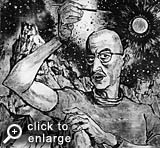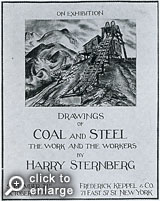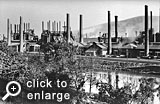December 2nd, 2011
I have a thing for depression-era depictions of industry and labor. That's why when I recently discovered the work of artist Harry Sternberg I was amazed - not only by the power of his work but also by the fact I hadn't discovered him sooner. So this post is a tribute to the work and passion of an artist I almost missed.


 Top:
Top: Sternberg self portrait, 1964
Middle: Coal and Steel exhibition poster, 1937
Bottom: A typical 30s-era steel mill skyline
To label Harry Sternberg an "obscure artist" would be inaccurate. He was not considered obscure in his day, but I think time has lumped him in with and overshadowed him by contemporaries such as Thomas Hart Benton, Grant Wood and John Steuart Curry. But Harry Sternberg stands apart for me - mainly because of a common interest in Pennsylvania's steel and coal industries. We have traveled to and gained inspiration from the same places; Sternberg during the height of those industries, and me after their decline.
Harry Sternberg was a New York artist whose career spanned an astonishing seven decades. His work evolved of course, and his medium and subject matter changed over time. Although I personally consider his amazing woodcuts to be the creme of his artistic output, it is his depression-era Coal and Steel body of work (only partially represented here) that speaks to me personally.
Unlike other successful artists of his time, Sternberg didn't attempt to glorify or romanticize the industries and workers he depicted. No smiling, Rockwellian workers proudly brandishing their tools. Instead of Saturday Evening Post covers, Sternberg illustrated covers for left-wing labor magazines such as New Masses. He spent time among the workers. He lived in their homes and went with them into their mines and mills. His work reflects the hardship and grit of their lives, and his experience among them led him to join in their fight for unionization. During this period of Sternberg's life, he used his art to challenge social norms and draw attention to the human condition. In addition to labor reform, Sternberg's work took on topics such as racism and fascism.
Though much has changed in the 75 years since Coal and Steel, much remains the same. Instead of the great depression, we now have the great recession. Sternberg's downtrodden workers eventually unionized and gave birth to the American middle class, only to be back on the ropes again in the 21st Century. Protest is again in the air. One thing has certainly changed: for better or worse, the tall, dark forests of spewing smokestacks are vanishing from the American landscape; with them the thousands of skilled and unskilled jobs contained within.
Art like Sternberg's was part of the social reform that came in the mid 20th Century. Decades later it gives us insight to depression-era life and the large problems society faced in those days. Art has always played a role in social reform and will no doubt play a role in the reforms of the 21st Century - as long as artists allow their work to follow their hearts and speak their minds.
Below is a sampling from Sternberg's Coal and Steel exhibit - Enjoy!